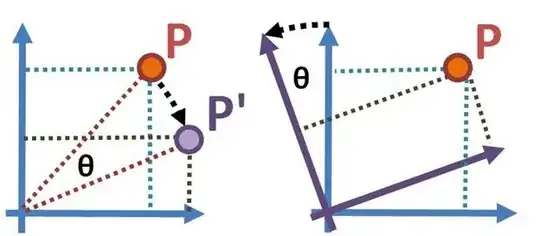I have a very general question about Lorentz transformations of electric and magnetic fields vs. 4-vectors . It arised from my previous post. I will describe the difficulty I encountered.
Information and problem:
- The electric and magnetic field in a system $S$ which can be boosted to a frame $\bar{S}$ moving at relative velocity $\mathbf{v}$. The electric field $\mathbf{E} =\mathbf{E}_\perp + \mathbf{E}_\parallel$ ($\perp$, $\parallel$ are with respect to $\mathbf{v}$) and the magnetic field $\mathbf{B} = \mathbf{B}_\perp + \mathbf{B}_\parallel$ will be transformed as:
$$\mathbf{\bar{E}}_\parallel = \mathbf{E}_\parallel$$
$$\mathbf{\bar{B}}_\parallel = \mathbf{B}_\parallel$$
$$\mathbf{\bar{E}}_\perp = \gamma(\mathbf{E}_\perp + \mathbf{v} \times \mathbf{B})$$
$$\mathbf{\bar{B}}_\perp = \gamma(\mathbf{B}_\perp - \frac{\mathbf{v}\times \mathbf{E}}{c^2}),$$
where $\gamma \equiv \frac{1}{\sqrt{1-\mathbf{v}\cdot \mathbf{v}/c^2}}$ is used.
My problem with these equations is as follows. There is an equality of vectors at each line visible. This means that if we have for instance $\mathbf{E}_\parallel = E_0 \mathbf{\hat{x}}$, $\mathbf{v} = v\mathbf{\hat{x}}$ and $\mathbf{B} = \mathbf{0}$ then $\bar{\mathbf{E}}_\parallel = \mathbf{E}_\parallel = E_0 \mathbf{\hat{x}}$ according to the definition. My problem is that $\mathbf{\bar{E}}_\parallel$ is expressed in terms of basis vector $\mathbf{\hat{x}}$ from frame $S$ and not a new basis vector say $\mathbf{\bar{\hat{x}}}$ in frame $\bar{S}$.
In the case of a Lorentz transformation of a 4-vector, we have that for example for the 4-potential $A \equiv \{A^{\mu}\} = (V/c,\mathbf{A})$ we have that $\bar{A}^{\mu} = \Lambda^{\mu}_{\nu} A^{\nu}$ and since the 4-vector itself does not change under a basis transformation we have $A = \bar{A} = \bar{A}^\mu \bar{e}_\mu = A^{\mu}e_\mu$, where $\{e_\mu\}_{\mu \in \{0,1,2,3\}}$ and $\{\bar{e}_\mu\}_{\mu \in \{0,1,2,3\}}$ are bases for $S$ and $\bar{S}$. The same Minkowski space is therefore described by different basis vectors in the 4-vector formalism when boosting to another frame. But in case of the electric and magnetic field (which I know do not form a 4-vector but are contained in the field tensor $\mathbf{F}$) do only change in components and not in the basis of $\mathbf{R}^3$. I have the feeling that 4-vectors do not change under a Lorentz transformation, only the components and the basis in which they are expressed (so the basis representation) and for 3-vectors, they change as a whole, meaning that the basis vectors can stay the same although the components change. But I am not sure about this.
- Coming back to the 4-potential. The components are also called $\bar{A}_x$, $\bar{A}_y$, $\bar{A}_z$, just like one can write $\bar{E}_x$, $\bar{E}_y$, $\bar{E}_z$ after a boost. Now the problem is if we write $\mathbf{\bar{E}} = \bar{E}^j \mathbf{e}_j$: is this basis also just $\{\mathbf{\hat{x}},\mathbf{\hat{y}},\mathbf{\hat{z}}\}$? And for $\mathbf{\bar{A}} = \bar{A}_x \mathbf{\hat{x}} + \bar{A}_y \mathbf{\hat{y}} + \bar{A}_z \mathbf{\hat{z}}$: is this also a valid expression?
- To conclude I think the main problem lies in the question whether a Lorentz transformation changes the basis in which 3-vectors (e.g. magnetic or electric field) or the 3-vector inside a 4-vector (e.g. 4-potential) are defined. And is the basis of $\mathbf{R}^3$ different from the basis of Minkowski space?
I hope someone can explain this rigorously by using equations.
